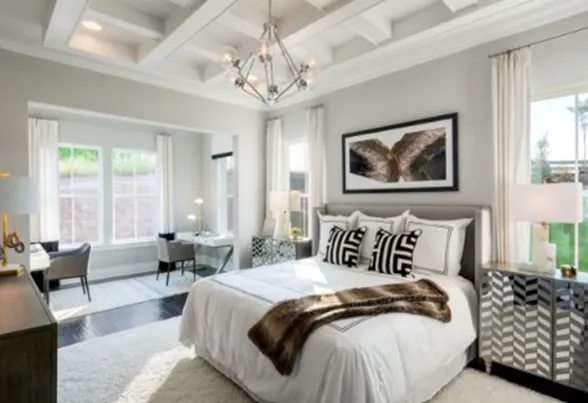There are basically three categories of bedrooms, and each serves a different purpose in the home.
- The Primary Bedroom is generally larger than the other bedrooms in the home and is intended to provide refuge, or serve as a relaxing getway from the daily grind of life, for the owner(s) of the home.
- The Kid’s Bedroom is used for not only sleeping, but also for playing and studying.
- The Guest Bedroom is where we hope to make our guests feel comfortable and welcome.
Regardless of the category, I was always taught the bed and its headboard should be the focus of a bedroom. It is, after all, the most dominant piece of furniture based upon its size. And since sleep is essential to our well-being, the bed plays a vital role in our lives.
PROPER PLACEMENT
As a focal point, the bed should either be on the wall directly across from the door or at 90 degrees off to the side. You should never enter directly to the side of the bed. Thus, the bed and headboard are visually dominant. Furthermore, the bed looks best when centered on the wall.

HOW BIG IS THE BED?
Whether you are designing a home or simply buying new bedroom furniture, it is critical to have the furniture fit the room properly. Here are some guidelines/measurements to help you select and place bedroom furniture:
A king-size mattress: 76” wide and 80” long. But a mattress is only part of the story. You need also to consider bedding, headboards, and footboards in some cases. A typical headboard is about 3” thick and 7′ long. Bedding adds another 2”. If a footboard is included, it adds another 3” to 4”.
A queen-sized mattress: 60” wide by 80″ long – the same length as a king-sized bed. Double or full-size mattress: 54” wide by 75” long. Full size and queen size beds typically use the same length of headboard. A twin mattress: 39” wide by 75” long. And don’t forget to account for the 30” to 36” for each nightstand when deciding the optimal wall for the bed.

WINDOWS
Natural light is a must in a bedroom, yet sometimes windows can pose an impediment to furniture placement.
Typically, bedrooms are rectangular with the bed on the long wall and windows at the end of the room on the short wall. If the room is big enough, there may be windows on the wall hosting the bed. Hopefully, the windows here are the right size to accommodate the size of your nightstands.

The bedroom, particularly the primary, should be our sanctuary, where our daily stresses melt away and we can hit the reset button to feel rejuvenated to take on the next day. A poorly thought-out bedroom that forces you to strategically navigate around furniture with the hope of not stubbing your toe in the middle of the night is simply a nightmare. Let’s make every bedroom a dream room—a retreat to look forward to. With some forethought and planning this will certainly be the case!
Adapted from Housing Design Matters Blog
